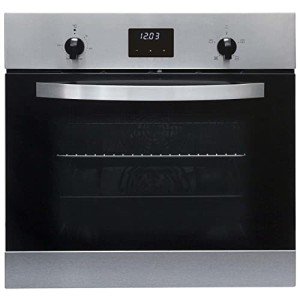20 Things You Should Know About Fan Oven For Sale
The Benefits and Advantages of Investing in a Fan Oven: A Comprehensive Guide
Recently, home cooking has actually gained significant appeal, leading many to look for efficient, versatile kitchen home appliances. One such device that sticks out is the fan oven, likewise known as a convection oven. With the capability to prepare food equally and effectively, fan ovens are ending up being a staple in kitchen areas across the globe. This short article explores the various benefits of fan ovens, aspects to consider when acquiring one, and responses to often asked questions about these ingenious cooking appliances.
What is a Fan Oven?
A fan oven uses a fan and an internal exhaust system to distribute hot air around the food. This style permits for even heat distribution, which can result in quicker cooking times and enhanced cooking outcomes. Unlike traditional ovens, which might experience locations, fan ovens ensure that every part of the food is evenly cooked.
Advantages of Fan Ovens
Faster Cooking Times:
- The efficient air flow in a fan oven often decreases cooking times by approximately 25%.
- This is especially beneficial when preparing bigger meals or multiple meals simultaneously.
Energy Efficiency:
- Due to quicker cooking times, fan ovens typically consume less energy than standard ovens.
- This can result in decreased electrical energy bills and is a more environmentally friendly option.
Versatile Cooking Options:
- Fan ovens can cook a wide variety of meals, from baking cookies to roasting meats.
- They often feature multiple cooking modes, such as baking, barbecuing, and steaming.
Even Cooking:
- The circulating air eliminates cold areas, ensuring that food cooks equally.
- This is especially beneficial for baking, where consistency is essential.
Much Better Browning and Crisping:
- The movement of hot air permits better browning on baked items and crispier textures on roasted foods.
- This can elevate the overall presentation and taste of meals.
Reduced Spillage:
- Many fan ovens include deeper trays and racks, which help include spills and splatters.
- This leads to easier cleanup after cooking.
Factors to Consider When Buying a Fan Oven
When choosing to purchase a fan oven, a number of elements need to be born in mind to ensure that it satisfies your cooking requirements and kitchen area.
1. Size and Capacity
It is important to choose a fan oven that fits your kitchen space and accommodates your cooking volume. Measure the designated location and think about the oven's internal capacity.
2. Functions and Functions
Search for ovens with features that will enhance your cooking experience. Typical features may consist of:
- Multiple cooking functions
- Self-cleaning choices
- Adjustable fan speeds
3. Energy Rating
Thinking about the energy effectiveness score of the fan oven can assist lower both your energy bills and ecological effect. Look for models with high energy ratings to make the most of cost savings.
4. Brand Reputation
Researching various brands will provide insight into which manufacturers consistently produce trustworthy and high-quality fan ovens. Ovens And Hobs and ratings can assist your choice.
5. Cost and Warranty
Fan ovens come in a range of price ranges. Develop a budget plan that fits your financial scenario, and inquire about service warranty alternatives to ensure you get assistance in case of defects.
Regularly Asked Questions (FAQs)
1. How does a fan oven differ from a routine oven?
A fan oven flows air with the assistance of a fan and exhaust system, enabling for even cooking and quicker preparation times compared to a traditional oven, which counts on stationary heat.
2. Can I use dishes designed for standard ovens in a fan oven?
Yes, you can adapt traditional dishes for a fan oven by reducing cooking temperature levels (generally by 20 ° C or 36 ° F) and keeping an eye on cooking times, as fan ovens generally cook food faster.
3. Are fan ovens more costly than standard ovens?
While the initial expense of a fan oven can be greater, the possible cost savings in energy expenses and faster cooking times may offset this expense gradually.
4. Do fan ovens require more upkeep than traditional ovens?
Maintenance requirements for fan ovens resemble those of standard ovens. However, the self-cleaning function available in many fan oven models can streamline maintenance.
5. What kinds of food are best fit for cooking in a fan oven?
Fan ovens stand out at cooking a wide range of foods, consisting of:
- Baked items like cookies and cakes
- Roasted meats and vegetables
- Casseroles and gratins
Investing in a fan oven can elevate the home cooking experience through its efficiency and adaptability. With its even heat circulation, much faster cooking times, and energy cost savings, it's no wonder that fan ovens are acquiring appeal amongst culinary enthusiasts. When thinking about a purchase, take into account elements such as size, features, and brand name track record to find the ideal design for your kitchen.
In summary, whether one is a passionate home cook or just seeks a dependable device, a fan oven stands out as an important addition to any kitchen. The balance of speed, quality, and energy efficiency makes these ovens a smart choice for the modern-day cooking landscape.
- * *
Summary Table: Key Benefits of Fan Ovens
Advantage
Description
Faster Cooking Times
Reduces cooking time by up to 25%.
Energy Efficiency
Takes in less energy, lower utility costs.
Flexibility
Numerous cooking methods for different dishes.
Even Cooking
Eliminates cold areas for uniform results.
Much better Browning
Produces crispier textures and boosts flavor.
Minimized Spillage
Deep trays help consist of food splatter.
- * *
By thinking about the info supplied in this short article, individuals can make informed decisions about acquiring a fan oven, guaranteeing they enjoy tasty home-cooked meals for many years to come.
